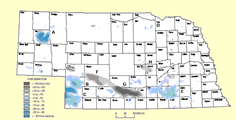Natural Resources, School of

Conservation and Survey Division: Faculty and Staff Publications
Document Type
Article
Date of this Version
10-18-2021
Citation
Published in Journal of South American Earth Sciences 112 (2021) 103601
doi:10.1016/j.jsames.2021.103601
Abstract
Groundwater recharge rate estimation is crucial to sustainable development of aquifers in intensely pumped regions, such as the Urucuia Aquifer System (UAS). A sedimentary aquifer in Western Bahia, Brazil, that underlies one of the major agricultural areas of the country where there has been major growth of irrigated areas. This study seeks to evaluate the recharge component of the water budget in the UAS area, based on three complementary techniques. The double-ring infiltrometer test was used to evaluate surface infiltration capacity, an important control on recharge. Water level data from wells (2011–2019 period, 19 wells) in the Brazilian Geological Survey’s Integrated Groundwater Monitoring Network (RIMAS-CPRM) was used to estimate the aquifer recharge using the water table fluctuation (WTF) method. Additionally, this study used the Soil Water Assessment Tool (SWAT) model in two selected sub-basins to estimate deep recharge from the surface hydrological data. The results of the infiltrometer tests show a notable difference in the infiltration rates between the natural vegetation zones and cropped areas. The WTF and SWAT simulations results suggest similar ranges of recharge rate (an average of 24% of precipitation, in both methods). Results of the study indicate equivalence of these methods to estimate the recharge in sedimentary unconfined aquifers as UAS.
Included in
Geology Commons, Geomorphology Commons, Hydrology Commons, Paleontology Commons, Sedimentology Commons, Soil Science Commons, Stratigraphy Commons


Comments
Copyright © 2021 Elsevier Ltd. Used by permission.